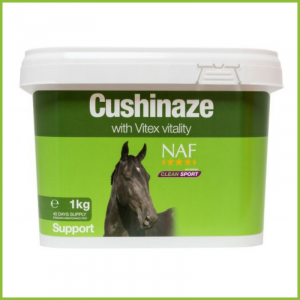Understanding Cushing's Syndrome with NAF
Kate Hore RNutr (Animal) R.Anim.Technol. Head Nutritionist at NAF
Cushing's Syndrome, also known as Pituitary Pars Intermedia Dysfunction (PPID) is a common condition of older equines, and is thought to affect at least 20% of horses and ponies over 15 years of age (1). As awareness increases more cases are diagnosed; what was once just a sign of getting older, is now often recognised as a symptom of Cushings.
Symptoms and signs of PPID/Cushings to look out for:
- Excessive sweating
- Long curly coats
- Difficultly shedding coat
- Excessive drinking
- Subsequent frequent urination
- Laminitis/Recurrent Laminitis
- Abnormal fat distribution
- Muscle wastage
- Recurrent infections
- Skin issues
- Parasite problems
But what really is going on with Cushings?
The pituitary gland sits at the base of the brain, and it is damage to this tiny area, that exerts such effects throughout the horse or ponies body. Whilst a healthy pituitary gland will allow the release and inhibition of hormones, in horses with PPID, the inhibitory processes are reduced due to nerve damage, causing excessive levels of hormones to be released within the body. Hormones control the desire for food and water, the shedding of the coat and even muscle health, so when these become unbalanced we see considerable changes in the normal body functions of our horses. Ponies are more commonly affected than horses, though there has not yet been any breed or sex bias found(1).
Laminitis is one of the best-known signs, and increasingly we consider recurrent laminitics to be 'pre-Cushings'. Alongside the Laminitis may be abnormal fat distribution, resulting in pads of fat or neck crests, even on restricted diets, the supra-orbital cavity above the eye is often noted, as this begins to bulge due to fat deposition. In other areas you may see muscle wastage or a potbellied appearance; recurrent infections, skin issues, or parasite problems are also typical with PPID and demonstrate the effects of a compromised immune system.
A Cushings/PPID diagnosis
Diagnosis by your vet will be based on a number of factors, including your horse's clinical history but also using blood tests to ascertain the levels of hormones within the blood. The TRH test looks at levels of ACTH (adrenocorticotrophic hormone), though frequently used, it isn't always reliable, particularly as hormonal output varies according to season, and the fact that many tests will produce false negatives when the disease is in its earliest stages. When used in combination with clinical observations and reports from owners, these blood tests can help to diagnose your horse's problem.
Once diagnosed, work with your vet on management, and it is advised to talk to qualified Nutritionists to ensure a suitable diet. Both the overall diet and targeted nutrition should be appropriate to your horse or pony.
Nutritional support for a horse with Cushings
NAF Cushinaze has been specifically developed for the horse with Cusahings/PPID. The careful blend of ingredients is designed to support vitality, provide nutritional support of the pituitary gland, optimise gut function and provide essential immune support.

References:
(1) McGowan T.A, Pinchbeck G.P & McGowan C.M (2013) Prevalence, risk factors and clinical signs predictive for equine pituitary pars intermedia dysfunction in aged horses. Equine Veterinary Journal. (45) 74-79
Enjoyed this blog? We've created a fantastic informative blog series with NAF that covers a huge breadth of important topics relating to your horse's health.
